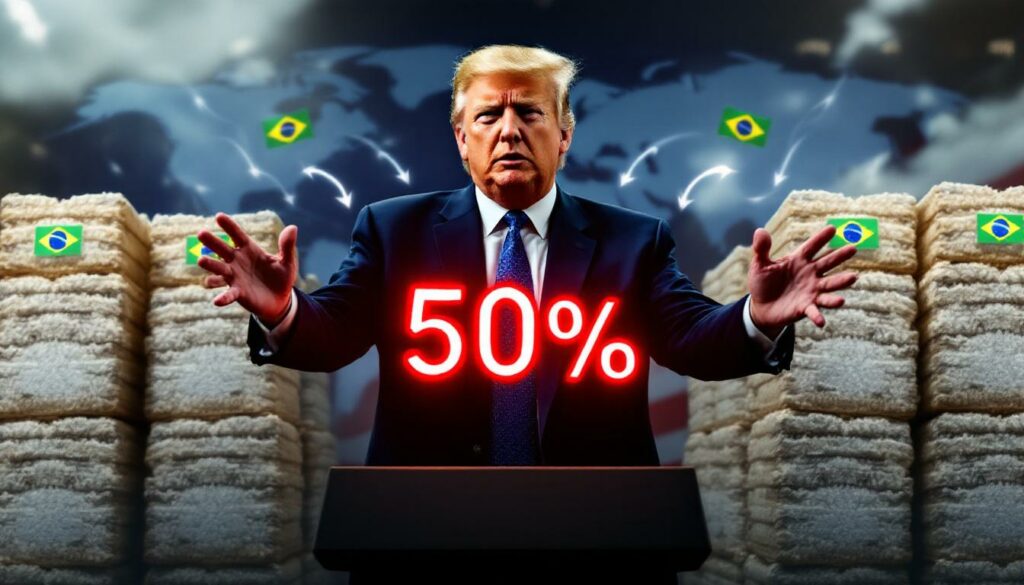Understanding Trump's Tariffs on US Imports from Brazil: Impact on Global Pulp Markets
The recent announcement of a 50% tariff on all Brazilian imports to the United States has sent shockwaves through global commodity markets, with the pulp industry particularly vulnerable to disruption. This sweeping trade action threatens to fundamentally alter supply chains that have been established over decades, creating both challenges and opportunities for market participants worldwide. The tariffs impact on investments could be substantial, affecting portfolios across multiple sectors.
Brazil has emerged as the dominant supplier of bleached eucalyptus kraft pulp (BEKP) to the American market, accounting for 82.5% of total US imports. In 2024 alone, Brazilian producers shipped over 2.8 million tonnes of this critical papermaking material to US buyers, highlighting the deeply intertwined nature of the two economies in this sector.
The current price of Bleached Hardwood Kraft pulp delivered to the US East Coast stands at $605 per tonne as of June 2025, down from the year's high of $645 recorded in April. These benchmark prices now face significant upward pressure as the market grapples with the implications of what would effectively be a $300+ per tonne tariff on Brazilian material.
As noted by pulp market analyst Mateus Saraiva, "The US is a key destination for Brazilian pulp, and any shift in trade policy could influence global supply chains. Other exporters with lower tariff exposure may gain competitive advantage, while downstream industries such as tissue and packaging could face cost pressures."
What Are the Details of Trump's New Tariff Policy on Brazilian Imports?
The 50% Tariff Announcement and Timeline
The surprise tariff was announced by former President Trump on July 9, 2025, through his Truth Social platform, catching markets off-guard and triggering immediate volatility in affected commodity futures. The measure is scheduled to take effect on August 1, 2025, giving businesses less than a month to adjust supply chains and contract terms.
The White House statement accompanying the announcement described the current trade relationship with Brazil as "very unfair" and cited the need to address "trade deficits" as justification for the sweeping measure. The comprehensive nature of the tariff—applying to all products imported from Brazil regardless of sector—represents an unusually broad approach compared to more targeted trade actions of the past.
Critically, the announcement provided no sunset clause or conditions under which the tariffs might be removed, creating significant uncertainty for long-term business planning and investment decisions in affected industries. These Trump tariff proposals follow a pattern of aggressive trade policies that have characterized the administration's approach.
Trade Relationship Reality Between US and Brazil
Data from official trade statistics paint a starkly different picture than the "unfair" characterization cited in the announcement. According to 2024 figures, the trade balance between the two nations actually favored the United States with a $283.8 million surplus.
Brazilian exports accounted for 49.8% of the bilateral trade volume, while US exports represented 50.2% of total transactions. These figures directly contradict claims of significant trade imbalance, showing instead a remarkably balanced commercial relationship.
The National Confederation of Industry of Brazil (CNI) President Ricardo Alban stated unequivocally that "There is no economic justification whatsoever for a measure of this magnitude," reflecting the widespread view among trade experts that the action appears disconnected from economic reality.
One notable omission in the announcement was any reference to a Section 301 investigation or other formal trade remedy process that would typically precede such significant tariff actions under established US trade laws.
How Will the Tariffs Impact the Global Pulp Market?
Brazil's Dominance in US Pulp Supply
The pulp market stands at the epicenter of potential disruption from these tariffs due to Brazil's overwhelming market share in the US. Brazilian mills supply 82.5% of US bleached eucalyptus kraft pulp (BEKP) imports, shipping over 2.8 million tonnes to American buyers in 2024 alone.
BEKP represents a premium-grade pulp prized for its unique fiber properties, including optimal length, brightness, and strength characteristics that make it particularly valuable for tissue, printing papers, and specialty packaging applications. These distinctive qualities make simple substitution challenging, as alternative hardwood pulps often require production adjustments.
The US market represents approximately 15% of Brazil's total pulp exports, making it a crucial destination for major producers like Suzano, Klabin, and CMPC. Current price assessments for Bleached Hardwood Kraft (spot), delivered US East Coast stand at $605 per tonne as of June 2025, having reached a 2025 high of $645 per tonne in April.
Transportation costs already represent a significant component of the delivered price, with container rates from Brazil to the US East Coast averaging around $4,200 per FEU (forty-foot equivalent unit) in Q2 2025. These logistics costs will become increasingly important as buyers evaluate the total landed cost of alternatives.
Potential Market Disruptions
The implementation of a 50% tariff would create unprecedented disruption across the pulp supply chain, forcing rapid realignment of trade flows globally. Markets are likely to experience several cascading effects:
-
Price Discovery Challenges: Spot markets may initially see extreme volatility as buyers and sellers struggle to establish new price levels that reflect the tariff reality
-
Supply Chain Redirection: Brazilian producers will likely redirect volumes to Asia and Europe, potentially creating oversupply conditions in those regions
-
Alternative Supplier Limitations: Current alternative suppliers including Canada (11% US market share), Portugal (7%), and Chile (5%) lack the immediate capacity to fill the Brazilian supply gap
-
Downstream Cost Pressure: US tissue, packaging, and paper producers face significant input cost increases, which will inevitably be passed to consumers
-
Production Adjustments: Tissue manufacturers may need to reformulate products due to fiber differences when substituting non-Brazilian pulp sources
As one tissue industry executive noted in response to the announcement: "This is potentially devastating for our industry. We simply cannot absorb a 30-40% increase in our primary raw material cost, nor can we quickly reconfigure our operations to use alternative fiber sources."
The 2018 US-Canada softwood lumber dispute provides a relevant precedent, where 20% tariffs led to a 9% spike in US prices as documented by the US Bureau of Labor Statistics, suggesting significant pass-through effects are likely. Such commodity market volatility has become increasingly common in recent years.
What Other Industries Will Be Affected by the Tariffs?
Steel Industry Implications
While pulp markets face severe disruption, the steel industry stands as another major sector bracing for impact. Brazil exported 3.4 million tonnes of steel slab to the US in 2024, representing approximately 60% of total US steel slab imports.
This high market concentration creates acute vulnerability for downstream steel processors, particularly re-rollers who convert these semi-finished slabs into finished steel products. The Instituto Aço Brasil (Brazil's steel industry association) has already issued a statement warning of "immediate supply chain disruptions expected in steel-reliant sectors."
US steel consumers across automotive, construction, and manufacturing sectors face potential material shortages and price spikes as alternative suppliers lack the immediate capacity to replace Brazilian volumes. Domestic US steel production remains insufficient to cover the potential gap, particularly for certain specialized grades.
"The proposed tariffs would directly impact approximately 15,000 American jobs in steel processing facilities that rely on Brazilian semi-finished imports as their primary input." — Instituto Aço Brasil statement
Broader Economic Consequences
Beyond pulp and steel, numerous other sectors face significant disruption:
-
Agricultural Products: Brazil provided 34% of US coffee imports in 2024 and 22% of raw sugar imports, according to USDA data
-
Automotive: Brazil exported $2.1 billion in auto parts to the US in 2024, with particular concentration in engines and transmission components
-
Chemicals: Specialty chemicals and petrochemical products represent another substantial import category facing disruption
The CNI has warned of "serious consequences" extending far beyond the directly affected industries, noting that supply chain reorganization costs will ultimately impact final consumer prices across numerous categories of goods.
The ripple effects will extend to port operations, logistics providers, warehousing, and financial services firms engaged in trade finance. Small and medium enterprises with less flexible supply chains face particularly acute challenges in adapting to the new trade environment.
How Are Brazilian Officials Responding to the Tariff Announcement?
Official Brazilian Government Position
The Brazilian government has responded swiftly and firmly to the tariff announcement. President Luiz Inácio Lula da Silva promised that "any unilateral increase in tariffs will be met with reciprocal measures under Brazil's Economic Reciprocity Law," establishing a clear expectation of proportional retaliation.
Brazil's Economic Reciprocity Law (Law 13.620/2018) provides the legal framework for mirror tariffs to be implemented within 30 days of the US action taking effect. This would potentially impact approximately $31 billion in US exports to Brazil, including critical categories like aircraft, petroleum products, and agricultural chemicals.
Diplomatic channels have been activated at the highest levels, with the Brazilian Foreign Ministry (Itamaraty) initiating formal consultations with US counterparts. Trade officials have emphasized the balanced nature of the bilateral relationship, highlighting the $283.8 million US surplus in 2024 as evidence contradicting claims of unfair trade practices.
Brazil is also expected to file a formal dispute with the World Trade Organization (WTO), adding to its 129 cases filed since 1995. However, the lengthy WTO dispute resolution process means this avenue is unlikely to provide immediate relief. According to a recent article from The Guardian, Brazil has described the move as "hostile and unjustified."
Industry Association Reactions
Brazilian industry associations have mobilized quickly to coordinate responses across affected sectors. The CNI is serving as the central coordinating body, working with sector-specific groups including:
- Instituto Aço Brasil (steel industry)
- Indústria Brasileira de Árvores (IBÁ – forestry and pulp sector)
- Associação Nacional dos Fabricantes de Veículos Automotores (ANFAVEA – automotive)
These organizations are pursuing a dual-track strategy: supporting government-to-government negotiations while simultaneously engaging directly with their US counterparts to highlight the mutual damage that would result from tariff implementation.
The pulp and paper sector, represented by IBÁ, has emphasized the integrated nature of the global supply chain and the absence of sufficient alternative sources to meet US demand in the near term. They are actively providing technical data to demonstrate the significant downstream impacts on US manufacturing and consumer prices.
What Are the Potential Global Market Implications?
Shifts in International Trade Patterns
The tariffs are expected to trigger significant redirection of trade flows well beyond the bilateral US-Brazil relationship. For pulp markets specifically:
-
Asian Demand Influence: Brazilian pulp producers will likely redirect volumes to Chinese and other Asian markets, potentially creating oversupply conditions and price pressure in those regions
-
European Market Dynamics: European buyers may benefit from increased Brazilian supply availability, but could face competition from displaced Asian buyers
-
Freight Route Adjustments: Shipping patterns will shift as Brazilian exports pivot from US to Asian destinations, requiring 15+ additional days per voyage according to Clarksons Research data
-
Alternative Supplier Capacity Constraints: US buyers will increasingly source from Canada, Portugal, Chile and Indonesia, potentially creating tight supply conditions in those origins
The EU pulp market, currently maintaining approximately 28 days' supply according to EUWID Pulp & Paper (June 2025), may struggle to absorb significant additional volumes without price adjustments. This could create opportunities for traders able to manage the logistics of redirected flows.
| Supplier Country | Current US BEKP Market Share | Annual Export Capacity (tonnes) | Expansion Potential |
|---|---|---|---|
| Brazil | 82.5% | 16,000,000 | Limited short-term |
| Canada | 11.0% | 2,100,000 | Moderate |
| Portugal | 7.0% | 1,400,000 | Minimal |
| Chile | 5.0% | 4,200,000 | Substantial |
| Indonesia | 3.5% | 5,800,000 | Substantial |
Ripple Effects on Related Industries
The tariff's impact extends well beyond direct importers to affect entire value chains:
-
Paper and Packaging Manufacturers: US producers face significantly higher input costs that will inevitably be passed to customers
-
Tissue Products: Consumer staples like toilet paper and paper towels will see price increases as manufacturers absorb higher raw material costs
-
Printing Sector: Commercial printers already facing digital competition will experience further margin pressure
-
Recycled Fiber Markets: Demand for recovered paper may increase as an alternative fiber source, potentially raising recycled pulp prices
For the steel value chain, similar cascading effects will impact construction, automotive manufacturing, and infrastructure projects. The construction sector is particularly vulnerable given tight project margins and the difficulty of passing through sudden cost increases on fixed-price contracts. The global tariff effects will likely be felt across multiple industries beyond just pulp and paper.
"This represents a fundamental restructuring of global commodity flows that will take months, if not years, to fully equilibrate. In the interim, extreme price volatility and supply disruptions are inevitable." — Commodity markets analyst at major investment bank
How Might Currency and Freight Factors Influence the Net Impact?
Exchange Rate Considerations
Currency dynamics will play a crucial role in determining the ultimate market impact of the tariffs. The Brazilian real (BRL) has historically shown sensitivity to major trade disruptions:
-
Currency Devaluation Potential: A weaker BRL against the USD could partially offset tariff impacts for Brazilian exporters, allowing them to maintain competitiveness despite the tariff burden
-
Central Bank Intervention: Brazil's central bank may adjust monetary policy to stabilize the currency, balancing export competitiveness against inflation concerns
-
Pricing Strategy Adjustments: Brazilian producers may implement dual pricing strategies, discounting non-US destinations to maintain market share while maximizing US returns where possible
-
Financial Market Implications: Equity valuations for publicly-traded Brazilian pulp producers (e.g., Suzano, Klabin) will likely reflect expected earnings impacts, creating volatility in associated financial instruments
The current BRL/USD exchange rate will be a critical factor in determining the net impact, as even a 10-15% currency adjustment could significantly alter the competitive landscape relative to other hardwood pulp producing regions.
Logistics and Transportation Dynamics
Freight markets represent another dynamic variable that will influence the tariff's effective impact:
-
Route Shifts and Rate Impacts: As Brazilian exports redirect from US to Asian destinations, shipping capacity allocation will adjust, potentially raising rates on Brazil-Asia routes while softening Brazil-US rates
-
Port Congestion Issues: US ports may experience initial congestion as importers rush pre-tariff shipments before the August 1 implementation date
-
Inventory Management Challenges: Warehousing capacity constraints may emerge as buyers stockpile material ahead of the tariff deadline
-
Transit Time Considerations: The longer voyage times to alternative markets (Brazil-Asia vs. Brazil-US) will increase working capital requirements for producers and potentially create short-term supply gaps
Current container shipping rates from Brazil to the US East Coast averaging $4,200 per FEU could see significant volatility as trade patterns adjust. Logistics providers specialized in pulp and paper transportation may need to rapidly reconfigure service offerings to match the new trade flow reality.
What Options Do US Pulp Buyers Have to Mitigate Tariff Impacts?
Alternative Supplier Exploration
US buyers face limited but critical options to navigate the new tariff landscape:
-
Canadian Supply Expansion: Increasing purchases from Canadian producers, though limited by the current 11% market share and capacity constraints
-
European Sources: Portugal (7% current share) offers similar fiber characteristics but limited expansion potential
-
Emerging Alternatives: Chilean and Indonesian producers offer substantial capacity but with different fiber properties requiring production adjustments
-
Domestic US Production: Current US hardwood pulp capacity of 3.7 million tonnes annually (according to AF&PA 2024 data) is insufficient to cover the Brazilian supply gap
-
Pulp Grade Substitution: Technical adjustments to accommodate different fiber characteristics when switching suppliers, particularly challenging for tissue producers
One significant limitation facing buyers is that BEKP substitution is technically challenging. Hardwood pulps from alternative origins like Chile or Indonesia feature shorter fibers that may require production adjustments for tissue manufacturers seeking to maintain product performance characteristics.
Strategic Inventory Management
Beyond alternative sourcing, buyers can implement several strategic approaches:
-
Pre-Tariff Stockpiling: Accelerating imports before the August 1 implementation date, though limited by working capital and storage constraints
-
Blend Optimization: Adjusting fiber recipes to reduce dependence on Brazilian material while maintaining product performance
-
Contract Renegotiation: Exploring force majeure provisions or material adverse change clauses in existing supply agreements
-
Hedging Strategies: Utilizing available financial instruments to manage price
Ready to Stay Ahead of Market-Moving Mineral Discoveries?
Discover significant ASX mineral opportunities before the market with Discovery Alert's proprietary Discovery IQ model, delivering real-time notifications on potentially transformative discoveries. Explore why major mineral discoveries lead to exceptional returns by visiting the Discovery Alert discoveries page and begin your 30-day free trial today.




